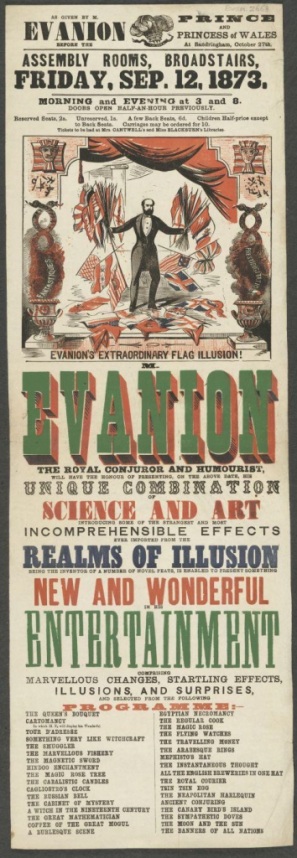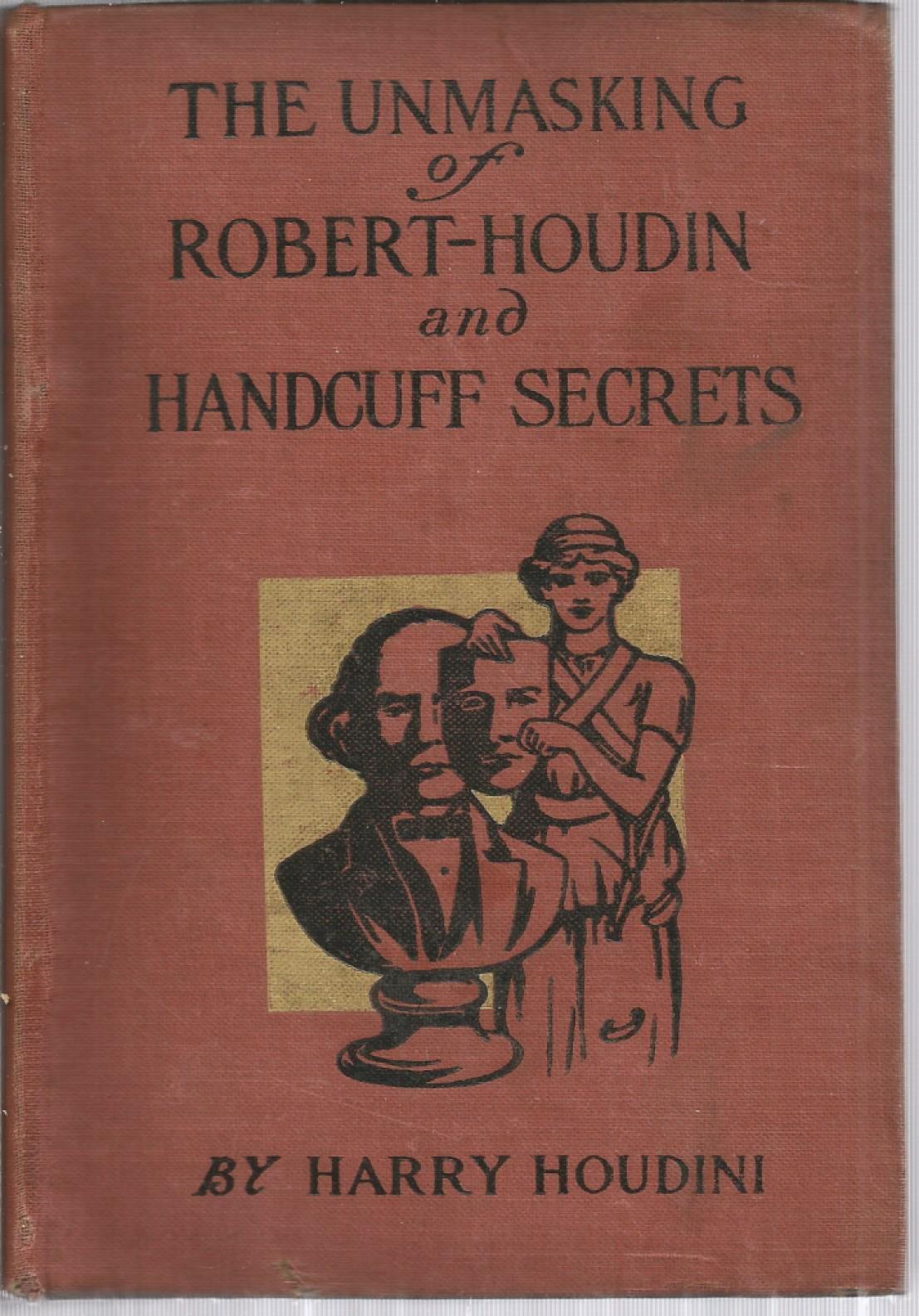Henry Evans (c. 1832 – 17 June 1905) was a conjurer, ventriloquist and humorist, who was born and lived in Kennington. Using the stage name Evanion he enjoyed a career spanning over fifty years. He was an inveterate collector who created a collection of around 5000 items of ephemera relating to popular Victorian entertainment and daily life that is now in the British Library as The Evanion Collection.
Early Life
Evanion, whose real name was Henry Evans was born in Kennington, probably in 1832. His father sold refreshments in the Vauxhall Gardens and was for a time landlord of the Black Prince public house. Evanion first performed magic at the age of seventeen.

Evanion was already attracted to conjuring as a boy, sometimes with dramatic consequences. His nephew, Robert Evans, recalls an occasion on which he staged a performance at the Black Prince which very nearly set fire to the building and the pigeons which his father kept there.
His Career
By the time he was 17, he had embarked on his professional career. During the early years, it seems, he had quite a struggle to make a living. He travelled extensively in Great Britain in company with another ventriloquist, Newman, and his family. By 1857 Evanion’s bills usually bore the name Evan Ion, soon combined into Evanion: he apparently adopted this as his legal surname, possibly in the 1860s (It was meant to sound French.)
Evanion continued to undertake performances until a few months before his death, in 1905. The heyday of his career was in the 1860s and 1870s. One sign that he had ‘arrived’ was his placing of advertisements in The Times of London.
He was primarily a drawing-room, or parlour, magician, entertaining in private homes for both adults and children.
Evanion performed in theatres and music halls across the country including performances for the Bishop of Winchester & the Lady Mayoress of London. Performances in front of members of the British Royal Family, including Queen Victoria at Sandringham, and the Prince of Wales (later Edward VII) and Princess Alexandra at Marlborough House, enabled him to use the name “The Royal Conjuror” in his publicity.
He is not only a very skilful professor of the art of legerdemain, but he is happy in possessing a rich vein of comic humour….the result is to excite laughter as well as wonder….His performance afforded the utmost amusement to all present, and he was warmly applauded throughout.
The Morning Advertiser reviewed one of those appearances:
His handbills advertised Evanion as the Royal Conjurer (capitalising on those performances for the Queen), and promised such illusions as the Flags of All Nations and the Inexhaustible Bottle—“astounding feats” whereby he “baffles the keenest observer.”

Collecting
Evanion was a legendary magic memorabilia collector, accumulating over 5000 items, of ephemera relating to popular Victorian entertainment and daily life that is now in the British Library as The Evanion Collection.
Later Harry Houdini would also purchase a number of items specifically related to magic and illusions from Evanion in 1904 and the collection gained further publicity.
Evanion had been collecting ephemera for years, but he had also devoted a considerable amount of time to researching his interest in the British Library Reading Room

British Library Collection
By the 1890s, in old age, in ill-health, and down on his luck, he apparently sold the majority of his collection to the British Library in 1895 for £20 – any more than that, it seems, and the purchase would have had to be approved by the trustees, who would undoubtedly have said no.
Since Evanion was a frequent reader in the British Library Reading Room, it is not surprising that he should have thought of selling part of his collection to the Department of Printed Books when he was short of money. The Department bought thousands of items from him in two separate transactions on 5 July and 3 October 1895.
View the British Library – The Evanion Collection & Picture Gallery
The Guardian’s review of the 2016 exhibition
Meeting Harry Houdini

In 1904, when Harry Houdini, ‘The Handcuff King’, was undertaking a tour of Britain, Evanion, noting from a local news interview that he had an interest in conjuring history, wrote informing him that he himself had ‘A very first class collection of Bills – Cuts and other items relating to Legerdemain and Conjuring over a period of nearly Two Hundred Years … the sub jcts [sic] are unique.’
Their meeting is detailed in Houdini’s book The Unmasking of Robert-Houdin. Houdini says that he spoke to the old man who had a parcel of old clippings and playbills to show Houdini. And here is where it gets truly interesting, in Houdini’s own words…“I remember only raising my hands before my eyes as if I had been dazzled by a sudden shower of diamonds.” This was Houdini’s reaction to seeing first hand, playbills belonging to Robert-Houdin, Phillippe, Katterfelto, Pinetti, Breslaw, Anderson and others. He completes the description with this, “I felt as if the King of England stood before me and I must do him homage.”
12 Methley Street – The House of Treasure
As a result of that first meeting, Houdini visited Evanion the following day at his house at 12 Methley Street, where Evanion showed Houdini his entire collection, and then led to their collaboration.
Read about Houdini’s visit here https://www.wildabouthoudini.com/2012/07/house-of-treasure.html
Evanion sold many of the finest items in his collection to Houdini, at a price that may have been less than fair. Although it should be said that Houdini’s payment for these purchases and also his employment of Evanion as a research assistant, would have given Evanion some financial security in the final year of his life.
Evanion’s research work, and that of his nephew, Robert Evans, (who later also worked for Houdini), are evident not only in The Unmasking of Robert-Houdin but also in Houdini’s Miracle Mongers and their Methods, although Houdini does not officially acknowledge their help.
Harry Houdini acquisitions can now be found in the Mesmore Kendall Collection housed in the Theatre Arts Library of the Harry Ransom Humanities Center at the University of Texas.
Death
Evanion died, impoverished, of cancer of the throat at Lambeth Infirmary on 17 June 1905. He was survived briefly by his wife who died not long afterwards.
Houdini paid a large part of Evanion’s funeral expenses (he was in the habit of endowing funds for the upkeep of the graves of magicians) and gave financial help to his widow, Mary.
Evanion’s Kennington
Black Prince Public House
The pub where his father was the landlord and where he performed in 1849 at the age of 17.
221 Kennington Road
Now replaced by the Rupert House, It was at this site his wife, Mary, ran a confectioner’s shop between the 1870s and 1880s, from their home provided a welcome additional income.
12 Methley Street
Evanion and his wife spent their final years in a number of smaller flats. His nephew Robert Evans wrote to Houdini shortly after Evanion’s death: ‘For years past the old couple have had nothing but the Workhouse confronting them.
https://www.wildabouthoudini.com/2012/07/house-of-treasure.html









